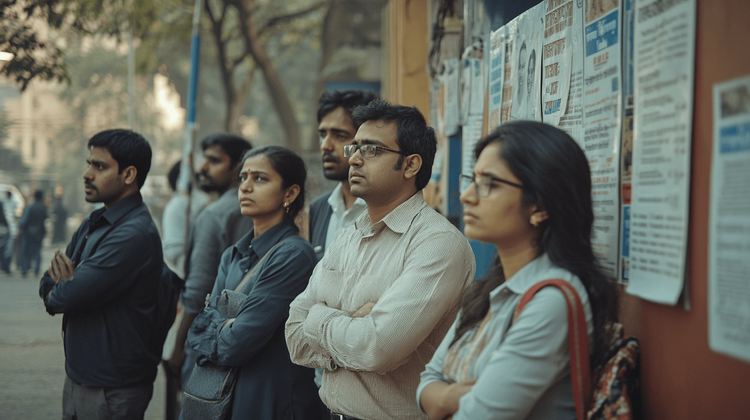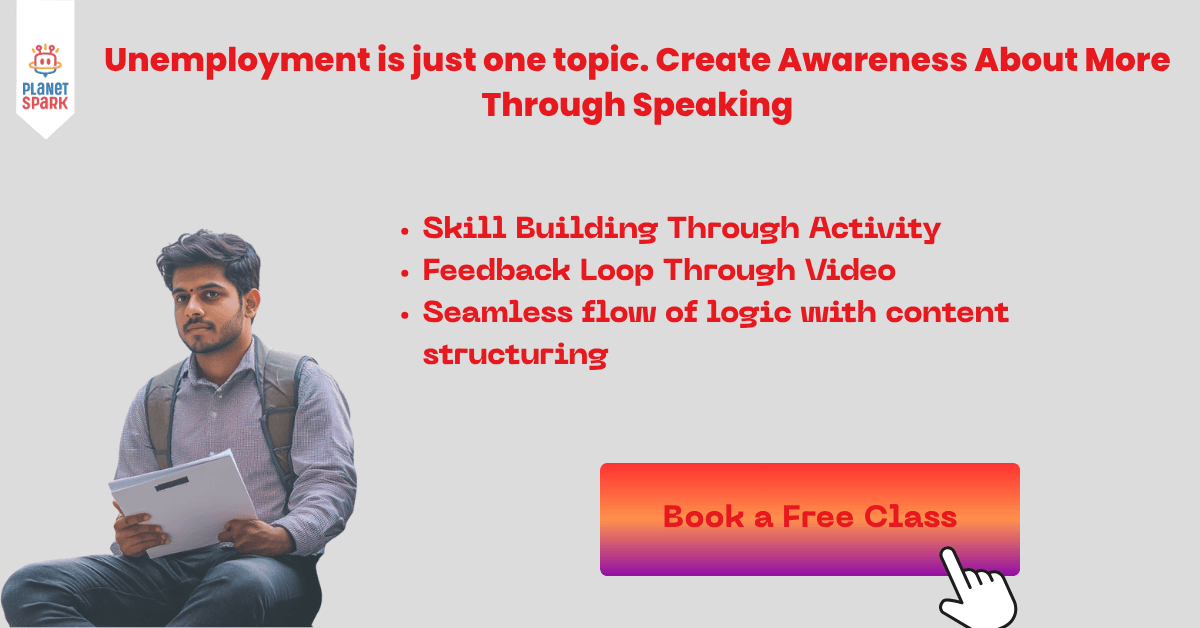Understanding Unemployment in India: Causes & Solutions

Good morning everyone! Today, we will discuss a topic that affects millions of lives worldwide, particularly in India: unemployment. A speech on unemployment is not just about quoting statistics or identifying causes; it is also about understanding the underlying issues. It’s about understanding how joblessness affects individuals, families, communities, and the overall economy.
Unemployment refers to the situation where individuals, despite having the necessary qualifications and willingness to work, are unable to secure gainful employment. This issue can affect one’s financial stability, emotional well-being, and sense of purpose.
In this detailed speech, we will explore the causes, consequences, and solutions of unemployment in India. We’ll also discuss how strong communication and public speaking skills, like those taught at PlanetSpark, can equip the younger generation to face the job market with confidence.
What is Unemployment?
Unemployment is a condition where individuals who are actively seeking work cannot find employment. It serves as a critical indicator of a nation’s economic health. A high unemployment rate reflects economic distress, underutilization of labor, and social instability.
The unemployment rate is typically expressed as the percentage of the labor force that is jobless and actively seeking employment.
Current Unemployment Statistics in India
According to the Labour Bureau of India and the Ministry of Statistics and Programme Implementation (MOSPI), the overall unemployment rate in India, based on the 2023-2024 Periodic Labour Force Survey (PLFS), was recorded at 3.2% in urban areas, with the rural areas reflecting a lower unemployment rate of around 2.1%. However, these figures do not capture the full extent of underemployment, which remains a significant issue. Many individuals in rural areas are engaged in part-time or low-wage jobs that fail to provide economic stability, often referred to as "disguised unemployment."
Additionally, youth unemployment remains one of the most critical concerns, with approximately 46% of the youth in the age group of 18-29 years being unemployed or underemployed, according to Niti Aayog's 2023 report.

Types of Unemployment
Unemployment in India can be classified into several categories:
Frictional Unemployment: Occurs as workers transition between jobs or enter the workforce for the first time. While this is natural in any economy, it is often prolonged in India due to mismatched job expectations and the dearth of relevant job opportunities.
Structural Unemployment: Results from a mismatch between the skill sets of workers and the available job opportunities in the market. For example, the rise of the technology sector has led to an increased demand for tech-savvy professionals, leaving many without the necessary qualifications to secure employment.
Cyclical Unemployment: Linked to the business cycle, cyclical unemployment increases during times of economic downturn. The COVID-19 pandemic and subsequent global recession led to massive layoffs and furloughs, exacerbating cyclical unemployment.
Seasonal Unemployment: Common in agriculture, this occurs when workers are employed only during certain times of the year, such as during planting or harvesting seasons, leading to joblessness during the off-season.
Disguised Unemployment: Predominantly seen in rural agricultural sectors, disguised unemployment occurs when more people are employed than necessary, and removing them does not affect productivity. It's particularly rampant in farming and small-scale agriculture.

Causes of Unemployment in India
The issue of unemployment in India is complex and influenced by several factors, including:
1. Population Growth
India’s population is expected to reach approximately 1.7 billion by 2050, which will only exacerbate the pressure on job markets. Every year, around 12 million young individuals enter the workforce, but the available jobs do not meet this demand.
2. Education System Mismatch
Despite India producing millions of graduates annually, there remains a significant gap between academic education and industry-relevant skills. According to a World Bank study, only 10% of graduates in India possess employable skills, leading to a large number of educated, yet unemployed, youth.
3. Technological Displacement
Technological advancement has led to the automation of many jobs that were previously done by humans, especially in manufacturing and retail. The World Economic Forum estimates that by 2025, 85 million jobs may be displaced due to automation globally, with India being significantly impacted, particularly in sectors like manufacturing, retail, and agriculture.
4. Slow Industrialization
While India has seen growth in the service and tech sectors, the industrial sector, which traditionally has been a major employer, has not grown as rapidly. As a result, there are fewer opportunities for large-scale, low-skill employment.
5. Inefficient Labor Market
The lack of a structured labor market, with informal employment opportunities being the norm, leaves a large section of the workforce vulnerable. A 2022 ILO report states that 90% of India's workforce is employed in the informal sector, which often lacks job security, legal protections, and a steady income stream.
6. Gender Disparities
Women’s participation in the workforce is disproportionately low in India, with many women leaving the workforce due to cultural barriers, caregiving responsibilities, and a lack of employment opportunities that accommodate these social roles. The World Bank reports that women’s workforce participation in India stands at 27%, the lowest in South Asia.
Impact of Unemployment
Unemployment doesn’t only affect individuals; its broader social, economic, and psychological consequences are detrimental to society:
1. Economic Consequences
Unemployment leads to an underutilized labor force, resulting in lower overall productivity, reduced economic output, and slower growth. With a significant portion of the population unable to contribute meaningfully to the economy, India’s growth potential is stunted.
2. Social Unrest and Crime
High unemployment rates can lead to frustration, protests, and social unrest. The 2019 NCRB (National Crime Records Bureau) report highlighted a noticeable increase in crimes linked to unemployment, especially among youth.
3. Mental Health and Well-being
The psychological impact of unemployment, particularly among youth, can lead to severe mental health issues, including depression and anxiety. Studies suggest that prolonged unemployment can increase suicide rates, especially in rural and semi-urban areas.
Youth and Unemployment in India
The youth of India, aged between 15 to 34 years, make up a significant portion of the country's population, constituting about 40% of the total workforce. Yet, they remain the most affected by unemployment. Despite India's substantial educational infrastructure, millions of young people, including graduates, postgraduates, and vocational students, struggle to find meaningful work. This issue stems from several key factors, including a mismatch between the education system and job market requirements, insufficient practical skills, and the inability to meet industry-specific demands.
Educational Mismatch and Lack of Job-Oriented Skills
India's education system has long been criticized for emphasizing theoretical knowledge over practical skills. While many young people graduate from universities and colleges with high academic qualifications, they often find themselves ill-prepared for the demands of the job market. Employers are increasingly looking for candidates who possess soft skills, technical expertise, and problem-solving abilities, but many graduates lack these qualities.
For instance, engineering graduates often possess a strong theoretical background but may lack hands-on experience or exposure to real-world applications of their studies. Similarly, commerce and arts students often lack industry-specific training that can directly lead to employment. According to a report by The Economic Times, over 80% of Indian graduates are not employable due to this gap in practical skills and job-specific competencies.
High Expectations and Limited Job Opportunities
Another reason behind youth unemployment is the disparity between job seekers' expectations and the number of opportunities available. The rural-to-urban migration further complicates the situation, as young people from rural areas often relocate to cities in search of better opportunities. Unfortunately, the urban job market cannot accommodate the overwhelming influx of job seekers, and many young people are left unemployed or underemployed.
The World Bank highlights that while India produces over 7 million graduates every year, the country’s economic structure is not able to create enough high-skill, high-paying jobs to meet this growing demand. Consequently, young individuals often accept low-wage, low-skill jobs in sectors like retail and hospitality, which do not match their education levels or aspirations.
The Gender Gap in Youth Unemployment
An even more concerning issue is the gender disparity in youth unemployment. According to a 2023 report by the International Labour Organization (ILO), the youth unemployment rate for women is significantly higher than for men, especially in rural and semi-urban areas. In many parts of India, social norms, lack of mobility, and gender-based violence hinder women from entering or remaining in the workforce. As a result, India's female labor force participation remains one of the lowest in the world at just 27%, as compared to the 80% in some Southeast Asian countries.
This not only limits the economic potential of young women but also restricts India’s overall growth trajectory. Empowering women with the right skills and creating a safe, supportive environment for them to thrive in the workforce is critical to addressing this issue.
Mental Health and Youth Unemployment
The toll of unemployment on the mental health of India's youth cannot be overstated. Uncertainty about the future, financial pressures, and social stigma around being unemployed can lead to feelings of worthlessness and depression. According to the National Institute of Mental Health and Neurosciences (NIMHANS), a substantial percentage of unemployed youth in India show signs of mental health disorders, including anxiety and depression.
In many cases, the emotional and psychological effects of unemployment delay or prevent young people from re-entering the workforce. Without adequate mental health support and access to counseling, these issues can spiral into more severe problems.
The Need for Communication Skills
India's youth can thrive and overcome many of these challenges with the right skills, particularly in communication. Developing proficiency in both spoken and written communication can open doors to a wide range of job opportunities across industries. Public speaking, storytelling, and effective communication are highly valued by employers in industries such as business, marketing, sales, media, and education.
In today’s competitive job market, youth need to master how to communicate clearly, express their ideas confidently, and engage in meaningful conversations with potential employers. This is where PlanetSpark's Public Speaking Courses become crucial. By offering live, interactive classes, one-on-one mentoring, and a personalized curriculum, PlanetSpark helps young individuals develop the essential communication skills they need to secure high-quality jobs.
These skills not only enhance employability but also equip youth with the confidence and resilience needed to overcome the challenges of an ever-evolving job market. Public speaking, for instance, can significantly improve interview performance, while storytelling skills can help them present their ideas more effectively, making them stand out in competitive job environments.
Youth Unemployment: A National Crisis with a Solution
Youth unemployment is not just a challenge for India’s young population but a crisis that holds back the nation’s growth. The future of India depends heavily on its ability to provide its youth with not just jobs, but meaningful careers that contribute to long-term personal and national development. This can only be achieved by bridging the gap between education and employment, offering skill development opportunities, and empowering young people with confidence and soft skills.

Government and Private Sector Solutions
To address unemployment, both the government and the private sector have initiated numerous programs and reforms.
1. Skill Development Programs
Initiatives like Skill India, Pradhan Mantri Kaushal Vikas Yojana (PMKVY), and National Skill Development Corporation (NSDC) are designed to equip the workforce with employable skills. However, the implementation and reach of these programs need significant improvement.
2. Encouraging Entrepreneurship
The Startup India Scheme and the Mudra Yojana provide financial and mentorship support to entrepreneurs, encouraging them to create job opportunities.
3. Job Creation through Infrastructure Development
Infrastructure projects in urban and rural areas, such as roads, railways, and industrial zones, can generate large numbers of jobs. The Atal Mission for Rejuvenation and Urban Transformation (AMRUT) aims to create sustainable urban spaces with job-creating infrastructure.
4. Improving the Education System
India must reform its education system to bridge the skill gap. This includes introducing vocational training, enhancing digital literacy, and making the education system more industry-centric.
5. Labor Reforms
The Indian government has made several efforts to streamline labor laws to make it easier to hire and fire employees while ensuring better conditions for workers. The Code on Wages, Industrial Relations Code, and Occupational Safety and Health Code are examples of recent labor law reforms that aim to improve the job market.
How PlanetSpark Helps Prepare for Employment
PlanetSpark offers specialized public speaking and communication courses that prepare individuals for real-world challenges. With live, interactive classes, students gain the confidence to face interviews, speak at events, and express ideas effectively. The program also includes personalized feedback, mock interviews, and activities that build soft skills crucial for any career path.
Conclusion
Unemployment is a major challenge that India must tackle with urgency. By focusing on skill development, educational reform, and creating job opportunities, we can overcome this issue. Empowering our youth with the right tools, such as communication skills, will pave the way for a brighter future. Let us all work together—individuals, educators, and policymakers- to eliminate unemployment and build a stronger, more prosperous India.
FAQs
1. What is the definition of unemployment?
Unemployment is the state where a person who is willing and able to work cannot find a suitable job.
2. What are the main causes of unemployment in India?
Key causes include population growth, lack of skills, slow industrial growth, and over-reliance on agriculture.
3. How can unemployment be reduced in India?
Through skill development, education reforms, encouraging entrepreneurship, and infrastructure development.
4. Why is youth unemployment a concern?
Youth unemployment leads to wasted potential and affects the economic and social stability of the country.
5. How can PlanetSpark help tackle unemployment?
PlanetSpark equips learners with communication and public speaking skills that improve their chances of employment and success in interviews.
Q6. Can communication skills training reduce unemployment in India?
Yes, strong communication skills can significantly improve employability by enhancing confidence, clarity, and presentation, key traits employers seek. Programs like PlanetSpark’s Public Speaking Course help bridge this skills gap.
Q7. How does PlanetSpark help learners prepare for future job opportunities?
PlanetSpark’s courses in public speaking, creative writing, and communication equip learners with essential soft skills needed in modern workplaces, boosting their career readiness from an early age.
Personalized Communication Report
Record a video to get a AI generated personalized communication report for your child

Hi There, want to try these
tips for your child with
LIVE with our expert coach?
Let's check your child's
English fluency
